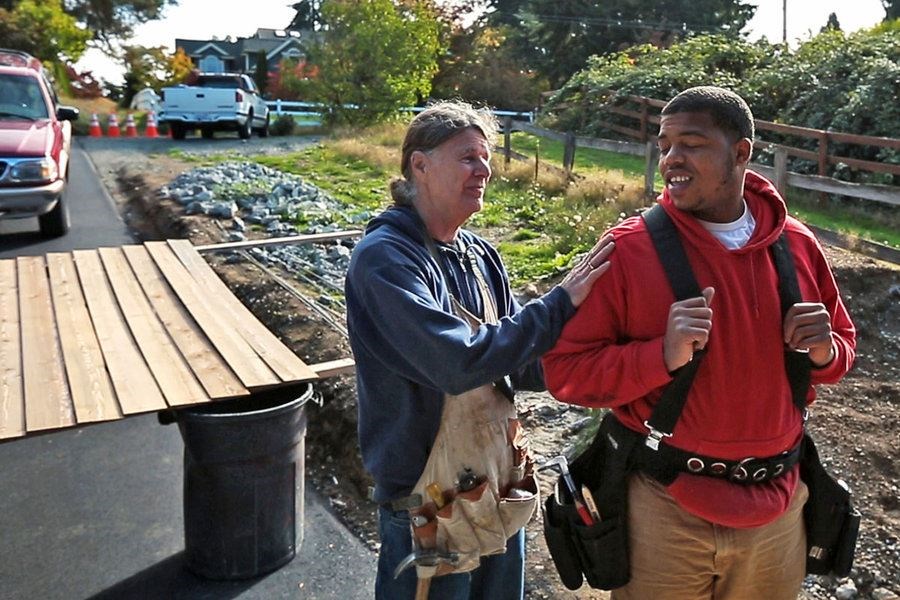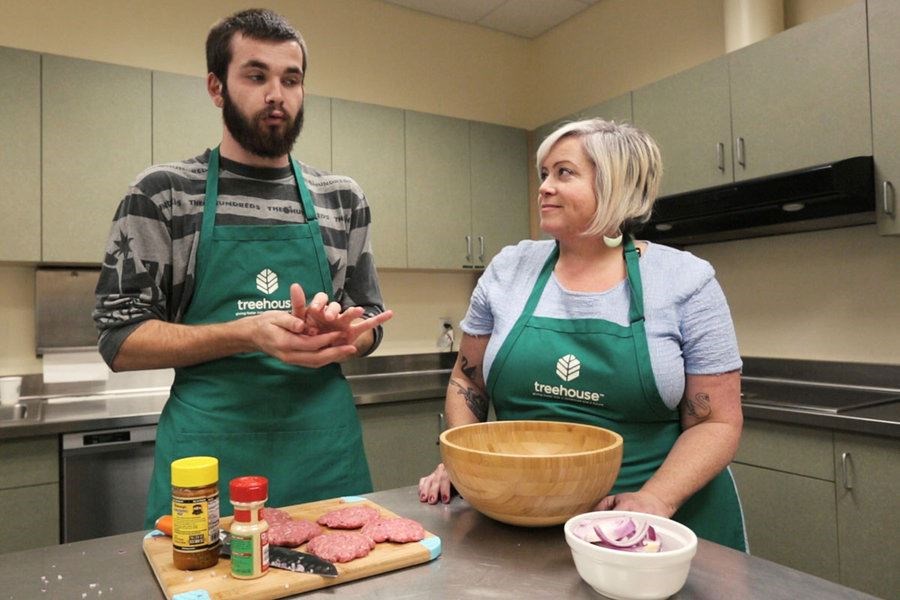Reprinted with permission from The Christian Science Monitor
As of July, a new law provides foster and homeless young people funding assistance for apprenticeships. One aim is to create options for the thousands of kids who face unemployment when they age out of foster care.
DECEMBER 20, 2018 - Working on a construction job in the Seattle area, Da’Sean Harrison marvels at the skills of a coworker and mentor he calls a “wizard.” He himself wants to be a general contractor, a master of all trades – a wizard.
 Da’Sean Harrison (r.) is honing his construction skills in Seattle. New legislation in Washington State will make it easier for young people connected with foster care to get apprenticeships by providing funding for necessities such as training and tools.Paul Joseph Brown/Courtesy of Youth Today“You would be hard to fire because you know so much,” the 22-year-old says with a slight chuckle. “My goal is to learn a lot about everything.”
Da’Sean Harrison (r.) is honing his construction skills in Seattle. New legislation in Washington State will make it easier for young people connected with foster care to get apprenticeships by providing funding for necessities such as training and tools.Paul Joseph Brown/Courtesy of Youth Today“You would be hard to fire because you know so much,” the 22-year-old says with a slight chuckle. “My goal is to learn a lot about everything.”
The path to a trade became easier this year for Mr. Harrison and other young people connected with foster care or homelessness in Washington State, where a new law provides funding for apprenticeships. Considered the first of its kind, the legislation – which became effective in July – aligns with a national trend to reinvigorate the trades and meet the demands of rebuilding infrastructure in the United States. Washington is still sorting out how much each applicant will receive, but its idea is already prompting interest from lawmakers in other states.
“One of the reasons it wasn’t something that many of us thought of years ago is that the data didn’t exist,” says state Sen. Kevin Ranker, a main sponsor of the law. “Politicians hadn’t been briefed on the fact that foster kids and then homeless kids are so much less likely to go to college or have an apprenticeship or have a career.... Now that the data is clear, it’s something that many of us want to act upon.”
Only 50 percent of young people in care complete high school by age 18, according to a summary of foster care education research published by the National Working Group on Foster Care and Education. That is lower than the national on-time graduation rate of 84 percent, based on the most recent measure from 2015-16. Of the more than 23,000 young people who age out of the US foster care system every year, just half will have a solid job by age 24.
 Shaunessy Jones (r.), associate director in community engagement for Treehouse, a 30-year-old nonprofit in Seattle that serves youth in foster care, works with Skyler Grandchamp, who is hoping to one day work as a chef. First of its kind legislation from Washington State provides funding for apprenticeships for students who are homeless or connected to foster care.Paul Joseph Brown/Courtesy of Youth TodayIn Washington, 30 to 40 percent of young people in care are interested in finding work or attending trade school directly after high school, says Dawn Rains, chief policy and strategy officer for Treehouse, a 30-year-old nonprofit in Seattle that serves youth in foster care and advocated for the law. According to the group’s research, 60 to 70 percent want to attend a two- or four-year college program.
Shaunessy Jones (r.), associate director in community engagement for Treehouse, a 30-year-old nonprofit in Seattle that serves youth in foster care, works with Skyler Grandchamp, who is hoping to one day work as a chef. First of its kind legislation from Washington State provides funding for apprenticeships for students who are homeless or connected to foster care.Paul Joseph Brown/Courtesy of Youth TodayIn Washington, 30 to 40 percent of young people in care are interested in finding work or attending trade school directly after high school, says Dawn Rains, chief policy and strategy officer for Treehouse, a 30-year-old nonprofit in Seattle that serves youth in foster care and advocated for the law. According to the group’s research, 60 to 70 percent want to attend a two- or four-year college program.
“We need people in the trades,” explains Shaunessy Jones, associate director of community engagement for Treehouse, which works with approximately 7,300 young people in foster care across the state. “We have a lot of kids in our program that want to do that sort of thing, work for Boeing, or work at a bakery, or become a dental assistant. And those are things you don’t have to go to four-year college for.”
The state’s Passport to Careers program, which became law on July 1, includes two programmatic pathways: the Passport to College and the Passport to Apprenticeship Opportunities. The law, SB 6274, is the first of its kind in the nation, says state Senator Ranker, chair of the Higher Education & Workforce Development Committee. It enhances Washington’s 11-year-old Passport to College Promise Scholarship program for homeless youth and youth in federal care by adding an apprenticeship path.
“I’ve been contacted by legislators in many other states actually considering the program now,” he says.
Moving forward, he wants apprenticeship training and trade school courses to count toward a degree. Specific legislation related to that failed to pass this past spring, he says, but he is hopeful it will be law in 2019.
Young people in foster care who are 16 and have been in care for at least a year are eligible for the Passport to Apprenticeship Opportunities program. The legislation’s intent is to fund the mandate sufficiently so that young people can eventually get aid toward apprenticeship programs when they are 13. It extends financial assistance to any eligible applicant for a maximum of six years, or until the applicant turns 26. The Washington Student Achievement Council administers the expanded program and is still designing how the awards will be distributed.
In Seattle, Harrison is part of an effort that predates the new law, Treehouse’s Graduation Success program, which helps students focus on completing high school and what they will do next. He says tools on his jobs can cost more than $1,500, something his coworkers on job sites have helped him with so far. Tools are among the items the new funding will cover, along with other occupation-specific costs, such as clothes and tuition for classes.
Skyler Grandchamp, also part of the Treehouse program, loves cooking. The 21-year-old has wanted to be a chef since he was 15. He plucks recipes off Facebook and whips up food for family and friends. But that is the extent of his opportunity right now. His dream: a two-story business with a cafe upstairs and a bakery downstairs.
“I think it is going to be very beneficial to a lot of kids who need financial support,” he says of the legislation, which he hopes will help him get the culinary training he needs. (Mr. Grandchamp, Harrison, and others in this story are featured in this video from Youth Today.)
Opportunities to study a trade can knock down obstacles for young people in foster care, Ms. Jones says. “They don’t have the luxury of being four years in college if they have nowhere to live or if they have to take care of a kid.”
Apprenticeships are a way forward, but instructors need guidance on how to work with young people who have potentially experienced trauma, says Angelique Day, a national expert on youth in foster care and an assistant professor of social work at the University of Washington.
And there are other issues, adds Mike Pergamit, a labor economist at the Urban Institute whose research is focused on vulnerable youth. For young people under the age of 16, he wonders about transportation, since they can’t drive, and legal age requirements for worker safety and hazardous job sites.
“Buying tools and uniforms, that’s great, but there will be some initial barriers like being housed that can interfere with taking a job of any kind,” Mr. Pergamit says. “Developing these apprenticeships, to be most effective, can’t be done in a vacuum. You have to work with child welfare and any other organization in creating the stability the youth needs.”
As youths in foster care consider what the best post-graduation path is, a priority is making sure high school career counselors are successfully assessing them, says Ms. Day.
“They need to take tests to understand what their strengths are, what kinds of careers are right for them and focus on some things that address personalities,” Day says. “Those guidance assessment tools will ask ‘Do you prefer to work with your hands?’ ”
Sharon Stukalo of Seattle was in the foster care system in high school and says that discussions with the school counselor were difficult.
“I remember the academic adviser telling me in a meeting, here’s how you fill out the forms for food stamps, don’t get pregnant until you’re 19, and you have to leave my office right now because I have another student coming because they are going to go somewhere in life,” recalls Ms. Stukalo, now in her 30s. “It didn’t matter to her that I was in honors classes and took college prep courses. I had the stigma of a foster kid and that’s what she went off of.”
Stukalo was in the Marine Corps for five years and the Army Reserve for 10. Now in the fifth year of an electrician’s apprenticeship program, she is a member of the International Brotherhood of Electrical Workers Local 46, the electricians’ union in Washington. Along with Local 46, she donates to the local shelter for homeless and at-risk youth. She escaped the grim economics of being in foster care, but she stays connected to the hardship.
“This legislation would have made a huge difference for me,” she says. “It would have meant a job, some training, a roof over my head, and not worrying, ‘Is my foster parent going to kick me out the next day because I’m over 18?’ ”
She adds, “This would have been an awesome option for me out of high school.”
This yearlong reporting project by Youth Today, the national news source for youth-service professionals, is made possible in part by The New York Foundling, which works with underserved children, families, and adults with developmental disabilities. Throughout this project, Youth Today will maintain editorial independence.
Page created on 12/20/2018 10:29:50 PM
Last edited 12/20/2018 10:42:18 PM
